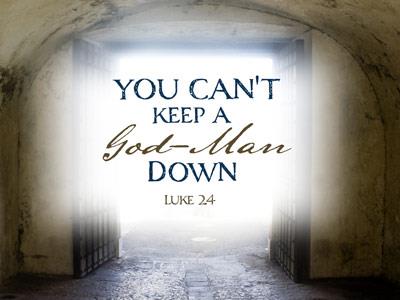-
Resurrection: A Theology Of Hope
Contributed by Matthew Kratz on Apr 10, 2020 (message contributor)
Summary: In Mark 16:1-7, we see the two elements of 1) The Grief (Mark 16:1–3) and 2) The Glory (Mark 16:4–7) of God the Father's Resurrection of God the Son bringing "A Theology of Hope"
• The great tragedy in hearing the reality of the resurrection year after year is the danger that it might become "old news" to some. The amazement comes in comprehending more and more of the totality of the story year after year. As we look deeper and deeper into the facts of the resurrection, we should get a broader picture of what God did, relating more and more historical and biblical facts together. In meditating and appreciating this to a greater and greater degree, should result in greater amazement and praise.
“Do not be alarmed,” says the angel (young man) to the women in Mark 16:6. This is a PRESENT IMPERATIVE with the NEGATIVE PARTICLE, which usually means to stop an act already in process (Utley, R. J. D. (2001). Vol. Volume 2: The Gospel According to Peter: Mark and I & II Peter. Study Guide Commentary Series (205). Marshall, Texas: Bible Lessons International.) What he means is, “Stop doing what you are doing, and instead rejoice, for this is a day of cheer.” The alarm and distress of the women also argue against a hallucination, for not only are group hallucinations virtually nonexistent, but the announcement of the angel entirely contradicts what the women expect. The position of the angel “on the right side” of the tomb, a detail without apparent significance, is not the kind of thing a fabricator would include and hence witnesses in favor of a historical remembrance. (Edwards, J. R. (2002). The Gospel according to Mark. The Pillar New Testament commentary (493). Grand Rapids, Mich; Leicester, England: Eerdmans; Apollos.).
• It may seem inappropriate to celebrate the resurrection of Christ as we are a church in exile. But it is only because of the resurrection of Christ that we can be commanded “Do not be alarmed”. The uncertainty of the age cannot overcome someone who’s life has been changed because of the resurrection. Christ had triumphed over COVID-19. Even death itself is not the end of the story. Because of the resurrection, Christ has triumphed over the grave. Because He is risen the promise of the resurrection is that those who trust in Him with rise as well (1 Cor. 15).
The Angel says specifically: “You are looking for Jesus of Nazareth/the Nazarene.” The inspired account leaves no doubt about who had been in the tomb. The idea of some unbelievers that the women went to the wrong tomb is ludicrous (MacArthur, J. J. (1997). The MacArthur Study Bible (electronic ed.) (Mk 16:6). Nashville: Word Pub.). Yes, Jesus was indeed "of Nazareth/the Nazarene,” the One who had spent most of his earthly life in Nazareth and voluntarily humbled Himself unto death, even death upon a cross. But now “He has/is risen.” God raised Jesus from the dead. The Resurrection was not an act of Jesus’ power, but a vindication of Jesus’ divinity (Barton, B. B. (1994). Mark. Life application Bible commentary (478). Wheaton, Ill.: Tyndale House Publishers.). This is confirmation of the Father’s acceptance of the Son’s substitutionary death (cf. I Cor. 15). Theologically, all three persons of the Trinity were active in Christ’s resurrection: the Father (Acts 2:24; 3:15; 4:10; 5:30; 10:40; 13:30, 33, 34; 17:31); the Spirit (Rom. 8:11); and the Son (John 2:19–22; 10:17–18) (Utley, R. J. D. (2001). Vol. Volume 2: The Gospel According to Peter: Mark and I & II Peter. Study Guide Commentary Series (205). Marshall, Texas: Bible Lessons International.). The announcement of the angel is literally the gospel, good news, and the place from which the gospel is first preached is the empty tomb that both received and gave up the Crucified One. (Jesus) “was raised” rightly implies that he was resurrected by God. At this moment and in this place the women are witnessing “the kingdom of God come with power” (9:1) (Edwards, J. R. (2002). The Gospel according to Mark. The Pillar New Testament commentary (494). Grand Rapids, Mich; Leicester, England: Eerdmans; Apollos.). The concept of the empty tomb, however, is especially useful as a symbol that death has been emptied of its power by the risen Christ. ( Brooks, J. A. (1991). Mark (Vol. 23, p. 270). Nashville: Broadman & Holman Publishers.)

 Sermon Central
Sermon Central



